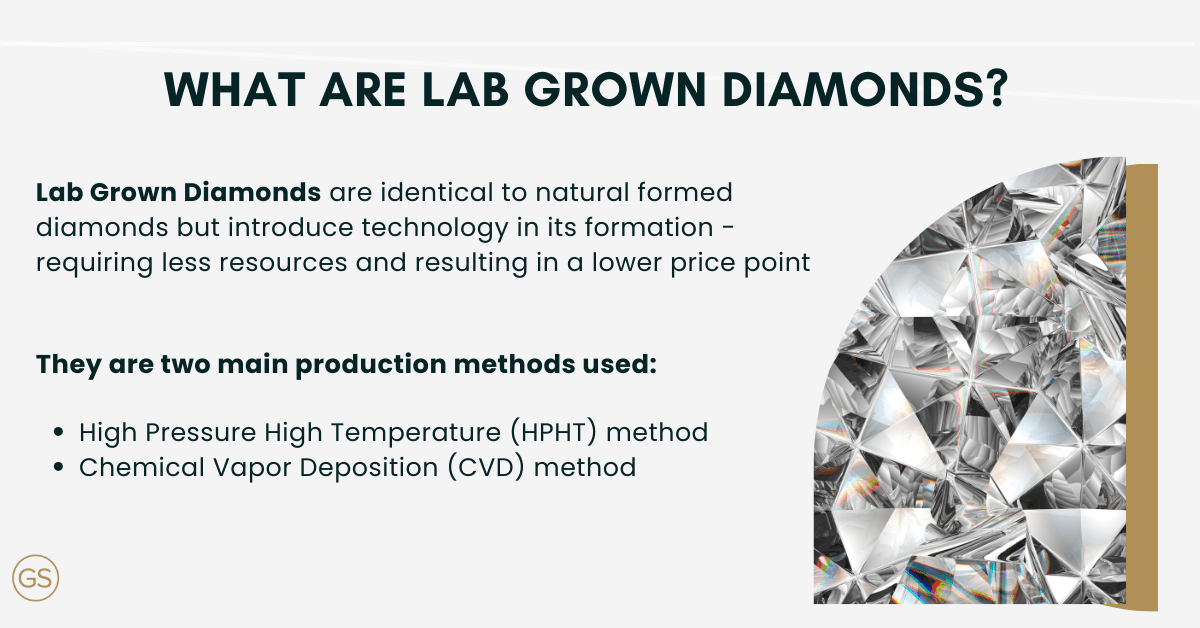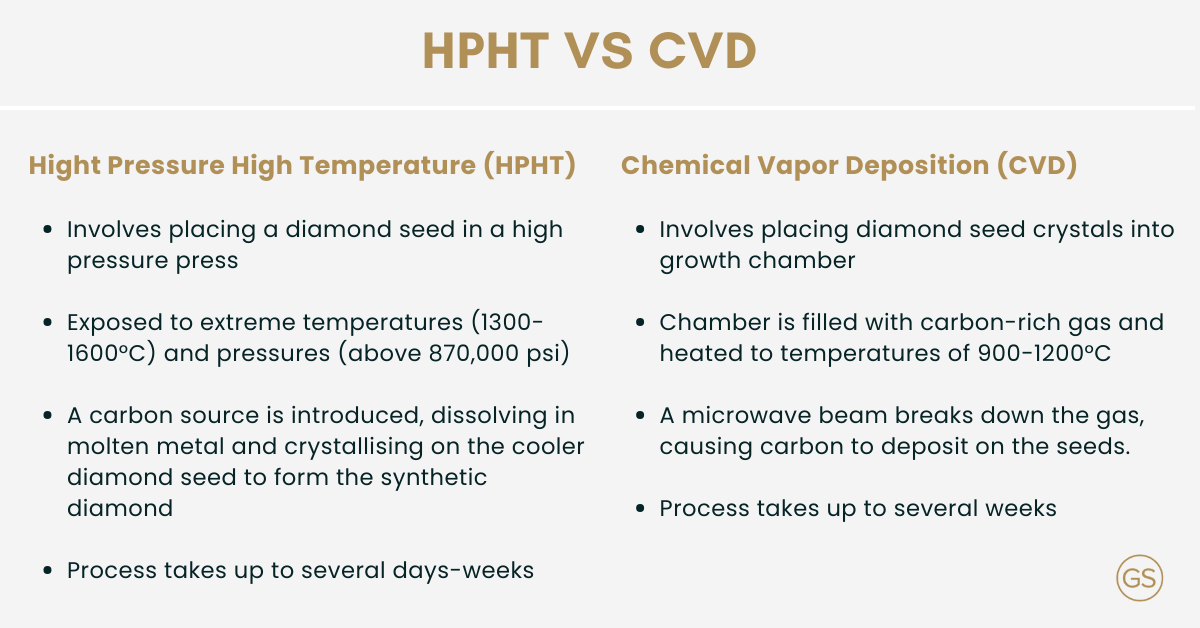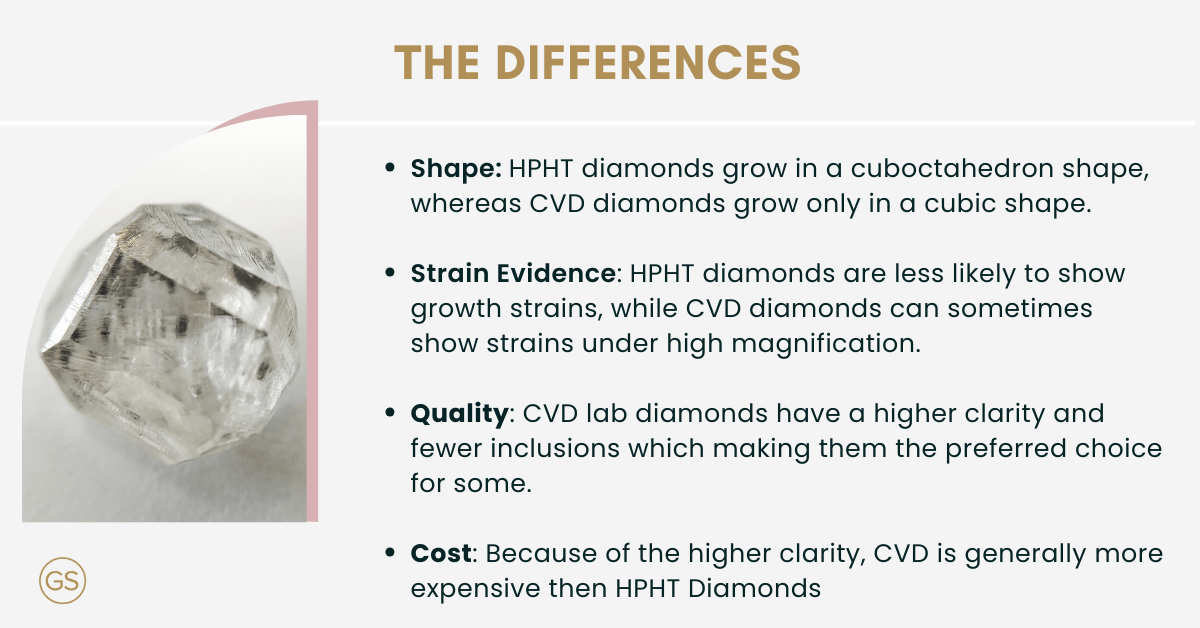
Lab grown diamonds, or man-made diamonds are amongst the fastest growing segments in the jewellery industry. Whilst the technology dates back to the 1950s, it has only been over the past few years where we have seen lab grown diamonds begin to breakthrough with mass market appeal. The latest research from CNBC found that global lab grown diamond sales have grown by almost 40% over the past 12-months with no signs of slowing down.
When it comes to lab grown diamonds, there are two main production methods that are employed: High Temperature (HPHT) and Chemical Vapor Deposition (CVD). For consumers weighing up between natural diamonds and lab grown diamonds, it’s important to understand that not all lab grown diamonds are the same, and that these two production methods lead to disparate outcomes.
In this article, we’ll take a look at the key differences between HPHT and CVD lab grown diamonds with a focus on quality, costs, and other key factors that consumers should be aware of when choosing between CVD and HPHT lab made diamonds.

Lab grown diamonds are identical to their natural forming counterparts, however, they take a new, technology driven approach to production that requires less resources and results in a lower price point for comparable natural diamonds.
Today, lab grown diamonds account for approximately 7-10% of all new diamond sales in the retail and shopping sector with numbers expected to continue increasing over the coming years.
The growing popularity of man-made diamonds can largely be attributed to their lower price point – around 20-40% lower than a comparable natural diamond. However, it’s also important to acknowledge the environmental and ethical concerns around diamond mining that are causing a shift in consumer sentiment. For younger buyers, the eco-friendly, conflict-free alternative afforded by lab grown diamonds is especially influential in the growth of the lab made diamond sector.
High pressure high temperature lab made diamonds or HPHT diamonds are created by placing a diamond seed into a high-pressure press which is then subjected to extreme temperatures (1300-1600°C) and pressures (above 870,000 psi) that mimic natural diamond creating conditions in the Earth’s mantle.
Under the high pressure and temperature conditions, a high-purity carbon source, typically graphite, dissolves in a molten metal flux which then migrates and crystallises on the cooler diamond seed to form the synthetic diamond. The production process for HPHT diamonds takes place in a small, high-pressure capsule over the course of several days to weeks. The HPHT lab grown diamond production process results in the growth of one or more diamond crystals which are then cut and polished by expert jewellers to the desired finish.
The chemical vapor deposition (CVD) lab diamond production method involves placing diamond seed crystals into a growth chamber. This chamber is then filled with carbon-rich gas and heated to temperatures of 900-1200°C. A microwave beam is used to break down the gas, which causes carbon to deposit onto the seed crystals.
The production process for CVD diamonds can last for several weeks, with the diamonds being periodically removed for surface polishing throughout the process. CVD diamonds are known to change colour throughout the production process, often starting as a dark, almost brown colour before becoming colourless through HPHT annealing. The chemical vapor deposition diamond production process allows for the simultaneous growth of multiple crystals – depending on the quality and size of the chamber and the seed quantity used.

So then, what are the key differences between HPHT and CVD lab grown diamonds?
HPHT and CVD lab grown diamonds use different production methods to achieve the same outcome. To the naked eye, it is not possible to tell the difference between HPHT and CVD lab grown diamonds. The differences between HPHT and CVD will only be discernible to a trained professional using specific equipment and an eye for the subtle differences.
HPHT diamonds grow in a cuboctahedron shape with 14 different growth patterns, while CVD lab grown diamonds only grow in the cubic shape. The more natural, irregular growth patterns of HPHT diamonds means that they are less likely to show evidence of growth strains. On the other hand, because CVD diamonds only grow in the cubic shape, they can sometimes be subject to evidence of strains under high magnification.
HPHT vs. CVD lab grown diamonds quality comparison isn’t as straightforward as most people would imagine. Determining the “better” option largely depends on personal preferences and specific requirements. As a rule of thumb, CVD lab diamonds typically have a higher clarity and fewer inclusions which makes them the preferred choice for those looking for a clear, colourless diamond.

CVD lab grown diamonds are typically more expensive than a comparable HPHT lab grown diamond. With higher clarity and fewer inclusions, chemical vapor deposition lab grown diamonds command a higher market price from those looking for a clear, colourless diamond.
It’s important to remember that the quality of CVD vs. HPHT diamonds will be the biggest determining factor in cost. It is possible for an equivalent HPHT diamond to be higher quality and command greater market prices than a CVD lab diamond if it is produced using superior production methods and materials.
When it comes to choosing lab grown diamonds and lab grown diamond jewellery, the same rules apply to natural, and lab made diamonds. Choose diamonds based on the 4 Cs of colour, clarity, cut, and carat. Remember, lab grown diamonds share the identical properties to man-made diamonds, so it’s important to buy from reputable dealers and choose a diamond that suits your budget and your unique preferences.